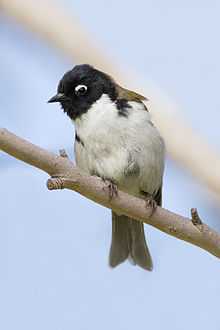Black-headed honeyeater
| Black-headed honeyeater | |
|---|---|
 | |
| Conservation status | |
| Scientific classification | |
| Kingdom: | Animalia |
| Phylum: | Chordata |
| Class: | Aves |
| Order: | Passeriformes |
| Family: | Meliphagidae |
| Genus: | Melithreptus |
| Species: | M. affinis |
| Binomial name | |
| Melithreptus affinis (Lesson, 1839) | |
The black-headed honeyeater (Melithreptus affinis) is a species of bird in the family Meliphagidae. It is one of two members of the genus Melithreptus endemic to Tasmania. Its natural habitats are temperate forests and Mediterranean-type shrubby vegetation. Despite its name, the black-headed honeyeater eats predominantly insects.
Taxonomy
The black-headed honeyeater was described in 1839 as Eidopsarus affinis. John Gould described it as Melithreptus melanocephalus in 1844, likely unaware of its earlier name.[2]
Molecular studies show the black-headed honeyeater is most closely related to the white-naped honeyeater, and that their next closest relative is the Swan River honeyeater. All are members of the genus Melithreptus with several species, of similar size and (apart from the brown-headed honeyeater) black-headed appearance, in the honeyeater family Meliphagidae. The next closest relative outside the genus is the much larger but similarly marked blue-faced honeyeater.[3] More recently, DNA analysis has shown honeyeaters to be related to the Pardalotidae (pardalotes), Acanthizidae (Australian warblers, scrubwrens, thornbills, etc.), and the Maluridae (Australian fairywrens) in a large Meliphagoidea superfamily.[4]
Description
A mid-sized honeyeater, it is olive green above and white below, with a wholly black head that lacks the white nape of its relatives. It has a blue-white patch of bare skin around the eye. Its beak is small.
Distribution and habitat
The black-headed honeyeater is endemic to Tasmania, where it is found in wet and dry sclerophyll forests, as well as scrub and heathland, and subalpine habitats to an altitude of 1200 m (4000 ft).
Feeding
Insects form the bulk of the diet, and the black-headed honeyeater specialises in foraging among the foliage of trees, as opposed to probing the trunk for prey which is practised by its relative the strong-billed honeyeater, and the two species rarely overlap.[5] Birds often hang upside down from branches while foraging.
References
- ↑ BirdLife International (2012). "Melithreptus affinis". IUCN Red List of Threatened Species. Version 2013.2. International Union for Conservation of Nature. Retrieved 26 November 2013.
- ↑ Campbell, AG (1938). "John Gould Amongst Tasmanian Birds". Emu 38 (3): 138–41. doi:10.1071/MU938138.
- ↑ Driskell, A.C., Christidis, L (2004). "Phylogeny and evolution of the Australo-Papuan honeyeaters (Passeriformes, Meliphagidae)". Molecular Phylogenetics & Evolution 31 (3): 943–60. doi:10.1016/j.ympev.2003.10.017. PMID 15120392.
- ↑ Barker, F.K., Cibois, A., Schikler, P., Feinstein, J., and Cracraft, J (2004). "Phylogeny and diversification of the largest avian radiation". Proceedings of the National Academy of Sciences 101 (30): 11040–5. doi:10.1073/pnas.0401892101. PMC 503738. PMID 15263073.
- ↑ Slater, Peter J. (1994). "Niche Overlap Between Three Sympatric Short-billed Honeyeaters in Tasmania". Emu 94 (3): 186–192. doi:10.1071/MU9940186.
